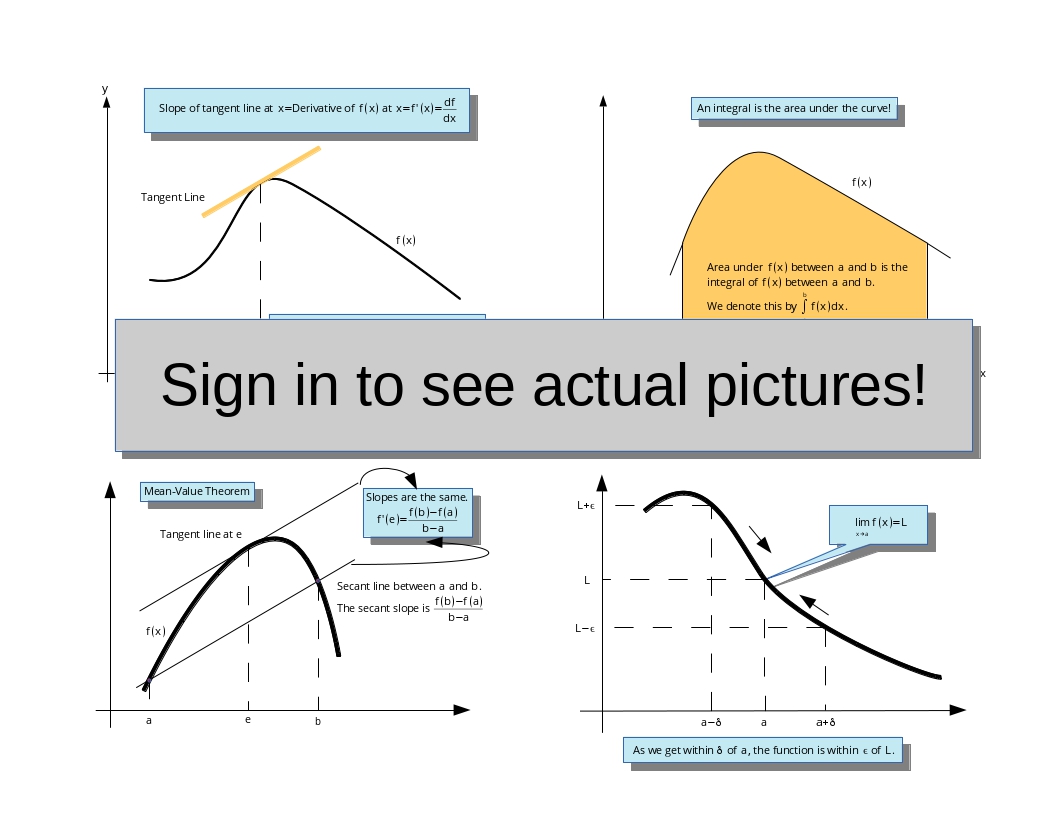Integration IV: Definite Integrals As Riemann Sums
Primary tabs
SAMPLE LESSON
Sign in for easy to read lessons narrowly focused on a specific subject. All lessons are linked to each other allowing you to easily see the connections between different Calculus concepts. Our unique Calcmap will give you a bird's-eye view of all our lessons and help you see how important concepts are related to each other. All of the formulas are available to our subscribers, but here is a sample of the lesson you will see when you log in:
First, we want to note that this is an alternative way of defining a definite integral that we first defined in our lesson on upper and lower sums. Think of this lesson as a completely different way of defining a definite integral. In fact, if you don't know anything about upper and lowers sums then you can easily start here if you would like. Some textbooks will begin a discussion of definite integrals with Riemann sums and others will begin the discussion with upper and lower sums. We will show that both viewpoints are equivalent.
Let's assume that we are asked to solve the definite integral
<Sign in to see all the formulas>
In other words, we are given a function f(x) and are asked to find the area under it between x=a and x=b. We make no assumptions on whether the function is continuous or even bounded.
Let's follow the recipe below to approximate the area under the curve by rectangles:
- Let's break up the x-axis between a and b into smaller, nonoverlapping closed intervals. This is discussed fully in this lesson. Let's assume that we do this with N closed intervals denoted by
<Sign in to see all the formulas>
Furthermore, recall that each closed interval has a length of
<Sign in to see all the formulas>
respectively. In the figure below we break the x-axis between the limits of integration a and b into three parts. The partition for this would be <Sign in to see all the formulas>.
- Pick an arbitrary point from each interval on the x-axis. We refer to each arbitrary point in <Sign in to see all the formulas> as <Sign in to see all the formulas>. For example, <Sign in to see all the formulas> is the arbitrary point we pick in the closed interval <Sign in to see all the formulas>.

- Approximate the area under the curve with the sum <Sign in to see all the formulas>. We call this number the Riemann sum of the partition and denote it by R(P). In the picture below we have
<Sign in to see all the formulas>

So in general, we can approximate the area under the curve with the area of a bunch of rectangles with the Riemann sum
<Sign in to see all the formulas>
where N is the number of partitions.
Before we go on we want to point out that we could have defined Riemann sums without the use of pictures. For example, the sum
<Sign in to see all the formulas>
is the weighted average of the points <Sign in to see all the formulas> where they are weighted by the relative length of each closed interval in our partition P of [a,b]. Our Riemann sum is then
<Sign in to see all the formulas>
In other words, the Riemann sum is b−a times the weighted average of the function between a and b. This makes sense because the area of a rectangle is a length (b−a in this case) times a height (average height of the function).
So now let's define the definite integral with Riemann sums:
| The Definite Integral |
|---|
Recall the lesson on partition limits. The definite integral is a number denoted by <Sign in to see all the formulas> such that<Sign in to see all the formulas>This means that for every <Sign in to see all the formulas> there exists a <Sign in to see all the formulas> such that every partition where <Sign in to see all the formulas> and any choice of <Sign in to see all the formulas> in each <Sign in to see all the formulas> then <Sign in to see all the formulas>When the number <Sign in to see all the formulas> can be found then we say that f(x) is Riemann integrable. |
It is important to note that this definition does not tell us what <Sign in to see all the formulas> is. Once we have a number we think is <Sign in to see all the formulas> then this definition will allow us to prove it or not. Don't worry too much about this though. There are a lot of techniques to help us find what the number <Sign in to see all the formulas> is.
At this point it is important to make a few comments. First, we have to admit that this definition is not very useful for a beginning Calculus student. Its usefulness is for Mathematicians to use in many logical proofs that show different things about integrals that are true. Second, if you are a beginning Calculus student then keep in mind that we are approximating the area under the curve by rectangles just like we did with our lesson on upper and lower sums. The only difference here is that we pick an arbitrary point in each interval to determine the height where the upper and lower sums use the minimum and maximum values of the function on each interval. Third, almost every Riemann integration problem a beginning Calculus student will encounter is nothing more than finding a Riemann sum and not finding the actual number <Sign in to see all the formulas>. So don't get overwhelmed by this. Do practice problems to find a Riemann sum and you should be very prepared for any test.
